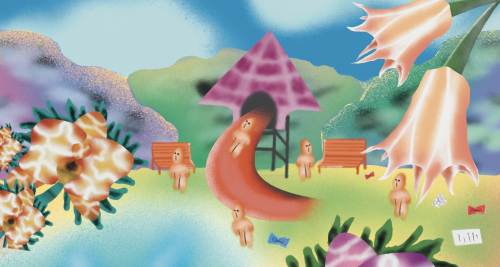Roovie’s Introspective Illustrations that Touch the Hearts of Many
Illustrator Muhammad Fatchurofi, better known as Roovie, began creating his calming and introspective illustrations shortly after returning home to Semarang. His focus on illustration was triggered by a shift in priorities, personal recovery, and a want to make work for himself. With clients like Clairo, LUSH, Chobani, Google, and more, his reflective work has touched the hearts of many.
Roovie has been drawing since he can remember, “The moment I held a pencil, I drew,” he said. “Since then, to this day [I’m] still drawing.” Naturally, he majored in Desain Komunikasi Visual (DKV), or visual communication design, at Universitas Dian Nuswantoro in his hometown, Semarang. Following his graduation, he positioned his practice into graphic design and worked as a designer and creative assistant at a studio belonging to artist Irwan Ahmett in Jakarta. “ Back then, because the mindset I had was that of a [graphic] designer, I had to be able to make illustrations from [style] A to Z,” Roovie explained. He feels that this is because design is solution-centric. According to him, one can say that becoming a graphic designer is more promising than becoming an illustrator. However, he felt that this occupation is less than ideal for Roovie who craved to make art for himself. His stint in Jakarta was intense and combined with what he described as an unhealthy lifestyle, Roovie was experiencing significant burnout which was beginning to impact his health. So, around 2015, Roovie decided to return to Semarang to allow himself time to recover. Two years later, he began to draw again–this time for himself.
Roovie describes his illustrations as somewhat simple but sincere. ”I mean the simple ones, the achievable ones, are the ones that seem to touch the hearts of many.” The drawings became a way for him to process his thoughts and experiences. “It really helped with regaining mindfulness.” Starting with his illustration series Being, which he felt was a form of journaling. His more personal pieces could be finished in one sitting and he found he was making three to four new pieces a week. “There are phases in life. Once that comes to a close, I end up with a whole series. Just naturally.”
“It’s all been centered on Instagram so far,” Roovie remarked. “Lately, I don’t get too wordy with my captions either. I feel like the image speaks for itself.” This account and his website are the main tools he uses to promote his work. He believes that a combination of maximizing his presence on Instagram, sticking to his routine, and media coverage allows him to grow professionally.

The world of illustration is changing but in Roovie’s opinion, that change is slow to come in Indonesia. ”The problem actually lies in the industry. The industry itself lacks appetite for illustration,” Roovie explained. “Then when someone does ‘buy’, the price rates are so low that it can’t be considered as an independent profession.” Although Roovie has been featured on many foreign media platforms, he has never been approached by local media before. “I think this is my first time being interviewed by a local media outlet,” he noted. “I’ve mostly been covered by foreign media outlets.” He has seen a lot of his peers in illustration seeking success beyond our borders although there are a few names to note in the country.
Of course, the experience of working for a local client and an international client has some notable differences. “It’s a big difference,” Roovie explained sardonically. “Whether it’s design or illustration, the clients in Indonesia are the trickiest,” Roovie continued wryly. “I mean, they feel like they know what to do.” Meanwhile, Roovie’s experience with clients beyond our borders tend to be more professional in terms of budget, contracts and creative rights as well as creative process. “Mostly nowadays, they’re kind of like ‘It’s up to you, what you want to draw.’” Bahkan kebanyakan, kalau sekarang sih, ‘Terserah kamu deh, mau gambar apa.’” Based on his experience, although not all clients abroad give Roovie that freedom, large scale clients actually tend to give him much more room for expression.
Currently Roovie is still working independently as he has for the past five years, although he has had several calls from agents offering to take him on board. However, he personally feels that as long as he is able, he wants to see how long he can maintain his practice independently. “Later down the line, when I feel that I’m hitting a wall and I want to focus on the work, then I might join an agency so they could help manage me.” Going forward he hopes that no matter the circumstances, he will still be drawing. He enjoys working in editorials and in music. He finds the conceptual nature of his work complements editorial works so he hopes to do more work in that field.















